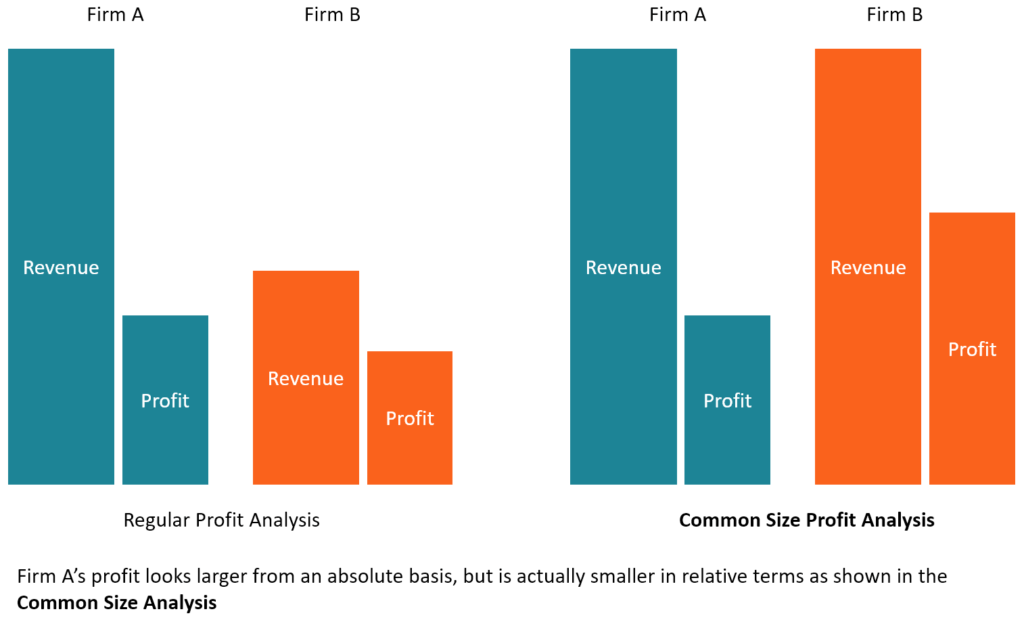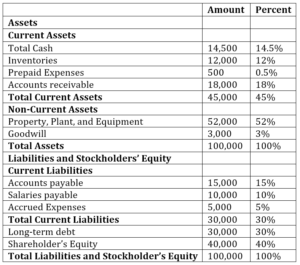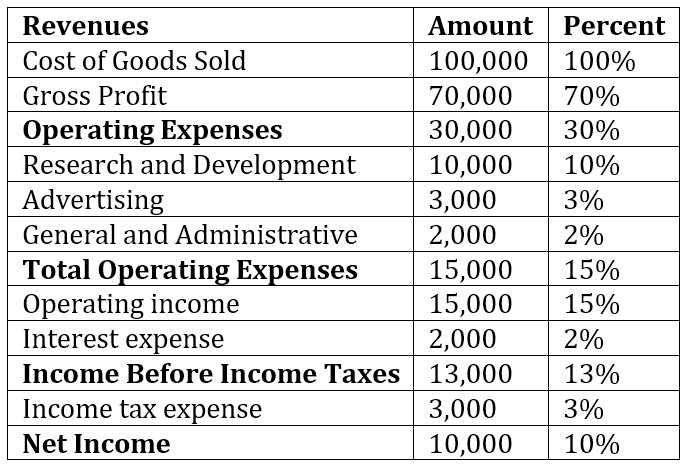How To Create A Common Size Income Statement
What is Common Size Analysis?
Common size analysis, also referred as vertical analysis, is a tool that financial managers use to analyze financial statements Three Financial Statements The three financial statements are the income statement, the balance sheet, and the statement of cash flows. These three core statements are . It evaluates financial statements by expressing each line item as a percentage of the base amount for that period. The analysis helps to understand the impact of each item in the financial statement and its contribution to the resulting figure.

The technique can be used to analyze the three primary financial statements, i.e., balance sheet Balance Sheet The balance sheet is one of the three fundamental financial statements. The financial statements are key to both financial modeling and accounting. , income statement, and cash flow statement Cash Flow Statement A cash flow Statement contains information on how much cash a company generated and used during a given period. . In the balance sheet, the common base item to which other line items are expressed is total assets, while in the income statement, it is total revenues.
Formula for Common Size Analysis
Common size financial statement analysis is computed using the following formula:
Types of Common Size Analysis
Common size analysis can be conducted in two ways, i.e., vertical analysis and horizontal analysis. Vertical analysis refers to the analysis of specific line items in relation to a base item within the same financial period. For example, in the balance sheet, we can assess the proportion of inventory Inventory Inventory is a current asset account found on the balance sheet, consisting of all raw materials, work-in-progress, and finished goods that a by dividing the inventory line using total assets as the base item.
On the other hand, horizontal analysis refers to the analysis of specific line items and comparing them to a similar line item in the previous or subsequent financial period. Although common size analysis is not as detailed as trend analysis using ratios, it does provide a simple way for financial managers to analyze financial statements.
Balance Sheet Common Size Analysis
The balance sheet Balance Sheet The balance sheet is one of the three fundamental financial statements. The financial statements are key to both financial modeling and accounting. common size analysis mostly uses the total assets value as the base value. On the balance sheet, the total assets value equals the value of total liabilities and shareholders' equity Stockholders Equity Stockholders Equity (also known as Shareholders Equity) is an account on a company's balance sheet that consists of share capital plus . A financial manager or investor uses the common size analysis to see how a firm's capital structure compares to rivals. They can make important observations by analyzing specific line items in relation to the total assets.
For example, if the value of long-term debts in relation to the total assets value is too high, it shows that the company's debt levels are too high. Similarly, looking at the retained earnings in relation to the total assets as the base value can reveal how much of the annual profits are retained on the balance sheet.
Let's take the example of ABC Company whose balance sheet for 2017 is as follows:

From the table above, we can deduce that cash represents 14.5% of the total assets while inventory represents 12% of the total assets. In the liabilities section, we can deduce that accounts payable represent 15%, salaries 10%, long-term debt 30%, and shareholder's equity 40% of the total liabilities and stockholder's equity.
Income Statement Common Size Analysis
The base item in the income statement Income Statement The Income Statement is one of a company's core financial statements that shows their profit and loss over a period of time. The profit or is usually the total sales or total revenues. Common size analysis is used to calculate net profit margin, as well as gross and operating margins. The ratios tell investors and finance managers how the company is doing in terms of revenues, and they can make predictions of future revenues. Companies can also use this tool to analyze competitors to know the proportion of revenues that goes to advertising, research and development, and other essential expenses.
We can compute common size income statement analysis for ABC Company for 2017.

By looking at this income statement, we can see that in 2017, the amount of money that the company invested in research and development (10%) and advertising (3%). The company also pays interest to the shareholders, which is 2% of the total revenue for the year. The net operating income or earnings after interest and taxes represent 10% of the total revenues, and it shows the health of the business's core operating areas. The net income can be compared to the previous year's net income to see how the company's performance year-on-year.
Importance of Common Size Analysis
One of the benefits of using common size analysis is that it allows investors to identify drastic changes in a company's financial statement. This mainly applies when the financials are compared over a period of two or three years. Any significant movements in the financials across several years can help investors decide whether to invest in the company. For example, large drops in the company's profits in two or more consecutive years may indicate that the company is going through financial distress. Similarly, considerable increases in the value of assets may mean that the company is implementing an expansion or acquisition strategy, making the company attractive to investors.
Common size analysis is also an excellent tool to compare companies of different sizes but in the same industry. Looking at their financial data can reveal their strategy and their largest expenses that give them a competitive edge over other comparable companies. For example, some companies may sacrifice margins to gain a large market share, which increases revenues at the expense of profit margins. Such a strategy allows the company to grow faster than comparable companies because they are more preferred by investors.
Download the Free Template
Enter your name and email in the form below and download the free template now!
Common Size Analysis Template
Download the free Excel template now to advance your finance knowledge!
Related Readings
CFI is the global provider of the Financial Modeling & Valuation Analyst (FMVA)™ Become a Certified Financial Modeling & Valuation Analyst (FMVA)® CFI's Financial Modeling and Valuation Analyst (FMVA)® certification will help you gain the confidence you need in your finance career. Enroll today! certification program for those looking to advance their career. To keep learning, the following CFI resources will be helpful:
- Analysis of Financial Statements Analysis of Financial Statements How to perform Analysis of Financial Statements. This guide will teach you to perform financial statement analysis of the income statement,
- Projecting Income Statement Line Items Projecting Income Statement Line Items We discuss the different methods of projecting income statement line items. Projecting income statement line items begins with sales revenue, then cost
- Comparable Company Analysis Comparable Company Analysis This guide shows you step-by-step how to build comparable company analysis ("Comps") and includes a free template and many examples.
- Financial Analysis Ratios Glossary Financial Analysis Ratios Glossary Glossary of terms and definitions for common financial analysis ratios terms. It's important to have an understanding of these important terms.
How To Create A Common Size Income Statement
Source: https://corporatefinanceinstitute.com/resources/knowledge/finance/common-size-analysis/
Posted by: juarezroake1984.blogspot.com


0 Response to "How To Create A Common Size Income Statement"
Post a Comment